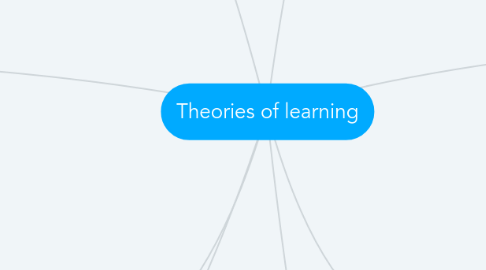
1. Hierarchy of needs
2. Behaviourism
2.1. Stimuli and response
2.2. Pavlov
2.2.1. Classical conditioning
2.2.1.1. Unconditioned response
2.2.1.2. Unconditioned stimulus
2.2.1.3. Neutral stimulus
2.2.1.4. Conditioned response
2.2.1.5. Conditioned stimulus
2.2.2. Experiment: The dog and the bell.
2.3. Watson
2.3.1. Little Albert experiment
2.3.1.1. Theory of emotions
2.3.1.1.1. Love
2.3.1.1.2. Rage
2.3.1.1.3. Fear
2.3.1.2. Experiment: Cat in a box
2.3.1.3. Stimuli generalization
2.4. Thorndike
2.4.1. Law of effect
2.4.2. Learning by repetition
2.5. Skinner
2.5.1. Operant conditioning
2.5.1.1. The form of learning concerned with changes in emitted responses as a function of their consequences.
2.5.2. Reinforcer
2.5.2.1. Primary reinforcers
2.5.2.2. Secondary/Conditioned reinforcers
2.5.2.3. Positive reinforcer
2.5.2.4. Negative reinforcer
2.5.3. Reinforcement
2.5.3.1. Contingency of reinforcement
2.5.3.1.1. Positive reinforcement
2.5.3.1.2. Punishment
2.5.3.1.3. Omission
3. Gestalt
3.1. Perception
3.2. The whole is more than the sum of its parts
3.3. Insight
3.3.1. True moment of learning
3.4. Laws that govern human perception
3.4.1. Law of Similarity
3.4.2. Law of Prägnanz
3.4.3. Law of proximity
3.4.4. Law of continuity
3.4.5. Law of closure
3.4.6. Law of figure
4. Information processing
4.1. Working memory
4.2. Long term memory
4.2.1. Permanent storage of information
4.2.2. Requires effort
4.2.3. Contents
4.2.3.1. Declarative knoledge
4.2.3.2. Implicit knowledge
4.3. Sensory memory
4.3.1. Iconic
4.3.2. Echoic
5. Bandura
5.1. Observation
5.2. SLT Observational learning
5.2.1. Attention
5.2.1.1. Observer pays attention to model
5.2.2. Retention
5.2.2.1. The observer remembers what was noticed
5.2.3. Motor reproduction
5.2.3.1. Observer imitates model
5.2.4. Motivation
5.2.4.1. Satisfying outcome = repeat behaviour
6. Constructivism
6.1. Active role of the learner
6.1.1. Integrated curriculum
6.1.2. Learner-centered Principle
6.1.3. Influence of social environment
6.2. Piaget
6.2.1. Adaptation
6.2.1.1. Assimilation
6.2.1.2. Accommodation
6.2.1.3. Equilibration
6.2.2. Cognitive development
6.2.2.1. Sensorimotor
6.2.2.2. Pre-operational
6.2.2.3. Concrete-operational
6.2.2.4. Formal operations
6.3. Vigotsky
6.3.1. Socio-historical theory of the mind
6.3.2. Comprehensible input: i + 1
6.3.3. Zone of proximal development
6.3.3.1. scaffolding
7. Howard gardner
7.1. Five minds for the future
7.1.1. Disciplined mind
7.1.2. Synthesizing mind
7.1.3. Creative mind
7.1.4. Respectful mind
7.1.5. Ethical mind
7.2. Multiple inteligences
7.2.1. Linguistic
7.2.2. Logical - Mathematical
7.2.3. Spatial
7.2.4. Musical
7.2.5. Kinesthetic
7.2.6. Interpersonal
7.2.7. Intrapersonal
8. Robert Gagné
8.1. Conditions of learning
8.2. Basic assumptions
8.2.1. Learning and growth are not equal
8.2.2. Learning is key in the individual's development
8.2.3. Learning generalizes to a variety of situations
8.2.4. Human learning is cumulative
8.2.5. Learning is not a single process
8.3. Framework for learning
8.3.1. Verbal information
8.3.2. Intellectual skills
8.3.3. Cognitive strategies
8.3.4. Motor skills
8.3.5. Attitudes
8.4. Phases of learning
8.4.1. Preparation for learning (Warm-up and activation)
8.4.1.1. Attending
8.4.1.2. Expectancy
8.4.1.3. Retrieval
8.4.2. Aquisition and performance (Comprehension and clarification)
8.4.2.1. Selective perception
8.4.2.2. Semantic encoding
8.4.2.3. Retrieval and responding
8.4.2.4. Reinforcement
8.4.3. Transfer to learning (Application and reflection)
8.4.3.1. Cueing retrieval
8.4.3.2. Generalizing
9. The montessori philosophy
9.1. Freedom of choice and motivation
9.2. Principles to chlid's psychic growth
9.2.1. Absorbent mind
9.2.2. Sensitive period
9.2.3. Prepared environment
9.2.4. Multi-age grouping
